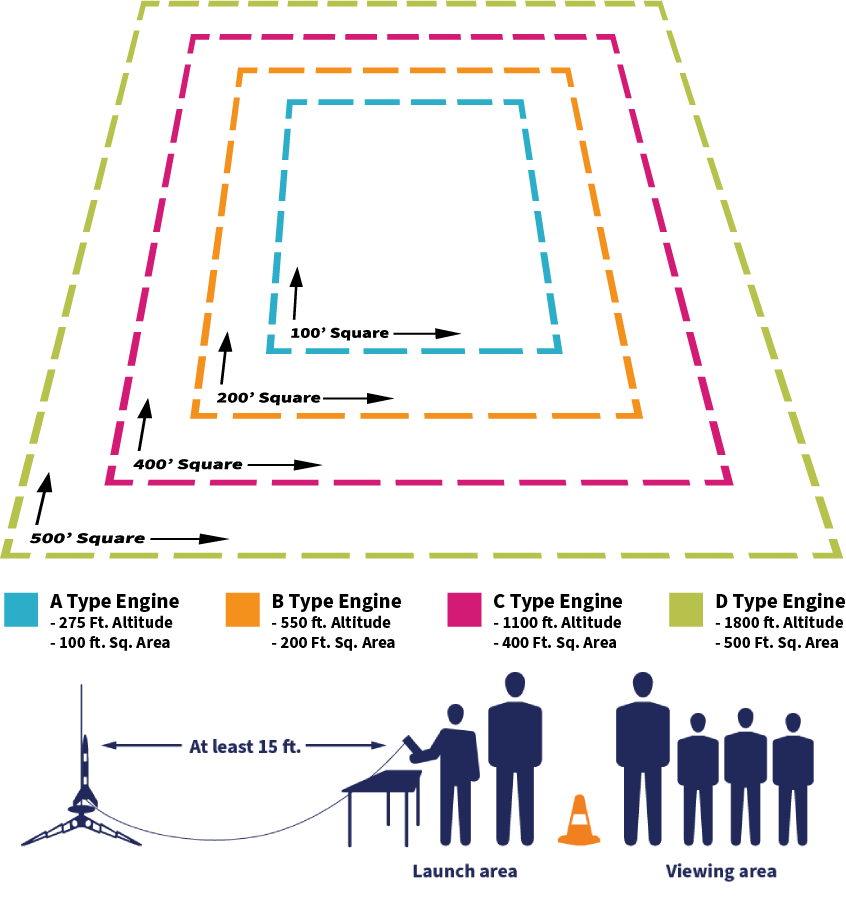New to Rocketry

1. Identify Your Lesson or Activity
Estes Education is committed to bring you lessons that inspire your students. Check out our materials including lesson plans that meet curriculum standards and youth program guides. Since rocketry is so much more than STEM, it is easy to add rockets to your class or camp with our resources!

2. Pick the Perfect Rocket
There are several things to consider when deciding which rocket is best for your group of students:
Age
For younger kids, we suggest our snap together rockets that have fewer assembly steps and little to no gluing. As rocketeers increase in age, they have the dexterity for more intermediate and advanced rockets.
Time.
It is important to think about available time to make and launch the rocket. Intermediate and advanced rockets require glue drying time and additional prep time before the launch. If limited on time, a beginner rocket would be perfect for you.
Launch Area.
The rocket engine you use determines the launch area required. Our smallest engines, (½ A or A) need 100 ft square area. As you increase in engine size (B, C, etc.), you need double the space since engines double in power with each subsequent letter.
If you are not able to launch a rocket at all, there are plenty of activities you can still do including our Rocket Stability Kit.

3. Choose Your Engine
Estes Industries is known for our solid propellant model rocket engines. Solid propellant engines allow people a consistent, safe, and reliable way to launch model rockets. Rocket engines come in various sizes and are single use. Single stage ½A, A, and B engines are a great starting out point for new rocketeers.
The Blast Off Bulk Pack is another great option that has a variety of engines to test.
Sometimes there are multiple engine options for a rocket so let’s break down the 3-part labeling system.

Total Impulse
The first part of the code is the letter (A – F) and designates the relative power or total impulse. Rocket engines double in power with each succeeding engine letter. For example, a B engine is twice as powerful as an A engine and an A engine is twice as powerful as a 1/2A.
Average Thrust
Following the letter is a number and it indicates the average thrust of a rocket motor. The larger the number, the higher the thrust. Therefore, a large thrust value will take off much faster. This can be important to consider for a few reasons. If you have a windy day, you might want the rocket to take off fast, so the wind doesn’t impact the trajectory or path of the rocket. You might also want a high thrust value if your rocket is heavy (or has a payload) to get your rocket to liftoff. An additional consideration is that a higher thrust value will experience more drag so it will not travel as high (if altitude is important).
Time Delay
The last value of the labeling system is another number and indicates the time delay in seconds. This tells you how long the rocket is going to coast. If your rocket is lightweight, you might want it to coast longer. On a windy day, you would also want a shorter delay, so the wind doesn’t carry your rocket away. If a delay is too long, your rocket could already be past its peak or apogee before it ejects its recovery system (parachute or streamer). A short time delay is used in two-staged rocket systems (more advanced rockets).

Get Your Accessories and Supplies
Launch Requirements
To launch your rocket, you will need a launch pad and controller. We recommend our Lifetime Launch System that comes with a controller, launch pad, and lifetime limited warranty.
Also required for every launch are starters, plugs, and recovery wadding.
- Starters heat the propellant and ignite your engine to launch. The igniter in the rocket engine nozzle is heated by an electric current supplied by a battery-powered launch controller. It is important that they are placed properly.
- Plugs hold the starters into place in the engines
- Recovery Wadding is flame resistant material packed between the recovery system (streamer or parachute) and model rocket engine to protect the recovery system from hot engine gases.
With every engine order, you will receive starters, plugs, and recovery wadding but it is often helpful to order extra of these items just in case.
Analyzing Altitude
Many of our lessons utilize tools to monitor model rocket altitude or height. The AltiTrak is a gravity protractor that uses simple geometry to calculate the height of your rocket. Estes offers 2 sizes –regular and mini (perfect for young rocketeers). The altimeter is a slim, lightweight device that has an LCD display to measure your altitude. The device must be placed in the rocket to calculate altitude.
Additional Requirements
Each rocket comes with detailed instructions and indicates what additional materials, if any, are required to assemble your rocket. Common items needed to assemble rockets include scissors, pencil, ruler, sandpaper, hobby knife, tape, plastic cement, carpenter’s glue, and/or paint. Many of these supplies you can find on our website, or you can find at your local hobby store.

Build Your Rockets
Follow Instructions
Prior to building with students, we recommend reading the instructions thoroughly and building at least 1 (or 2) rockets. This ensures that you have all the materials, understand the instructions, and also created a building reference for the students. Be sure to follow the instructions as closely as possible. When building the rockets with your group or classroom, it is important to think about the age and abilities of the students – some students might do well in a self-paced session, while others might succeed if following the instructions stepwise in a group.
Assemble Carefully
There are small parts in the rocket kits and students can easily lose these parts. We suggest having a tray or cup for students to place their pieces so nothing gets lost. Many rockets also require gluing and it is crucial to use the correct glue. For connecting plastic pieces, like when prepping a nose cone, plastic cement should be used. To adjoin paper parts, like when adding the engine block into a body tube, yellow wood glue should be utilized. Wood glue grabs onto paper-to-paper joints quickly so placing parts like the engine block or engine mount need to be done in a quick, singular motion. Students should test the fit of parts before gluing them together. Make sure the glue is completely dry before moving onto the next steps.
Get Creative
The last step of any rocket build is the final design touches. Each Estes rocket is unique in terms of their design. Some rockets require a few decals or stickers to be added onto pre-colored parts while other rockets need to be painted before any decals are added. The Generic E2X, on the other hand, is a blank canvas and ready for any design! Allow students to get creative with their final touches.

Prepare Your Rocket for Launch
Now that your rockets are complete, we recommend preparing as much as possible ahead of time and before heading outside.
Recovery System
- Crumple the appropriate amount of wadding as listed in the instructions and shove into the body tube.
- Fold the parachute or roll the streamer, and then place into the body tube.
- Close the body tube with the nose cone.

Rocket Engine
- Place the starter tip into the exhaust port of the engine. (This is the side of the engine with a small indentation.) Place the tip as far into the engine as it can go. The starter must be touching the propellant in order to ignite the engine.
- Use the plug to hold the starter into place.
Payloads
Payloads are cargo (equipment, goods, or materials) carried by a rocket. Some rockets, like The Green Eggs, have an additional section to hold a payload. Payload sections allow for exciting experiments such as monitoring altitudes with an altimeter or launching and recovering an intact egg safely. This is the step you should load your rocket with your payload. If the rocket has a payload, place the item in the payload section. If the rocket does not have a payload section and you are using an altimeter, connect the altimeter to the nose cone and pack it into the body tube with the recovery system.

Get Your Group Ready to Launch
Choose the Launch Location
- Stay away from power lines, buildings, tall trees, and low flying aircraft.
- School athletic fields or parks are adequate for small size rockets but consider the rocket engine before picking a location to launch.

Setting up you launch for a class or large group
- Establish launch rules before heading to the launch area! Rules can include launch order, spectator location, and who gets to launch the rocket and recover the rocket (we suggest the rocket creator).
- We recommend utilizing tables and cones to designate a launch area and a viewing area as shown below. Only launch crewmembers should be close to the launch site.
Need help?

Launch!
You are prepped and ready to fly! Watch the video below for more tips on how to launch with a group of students.

